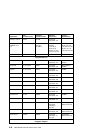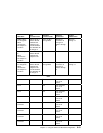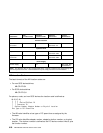
Specifically, the format of a location code is defined as follows:
pn[.n][- or /]pn[.n][- or /]...
Where p is a defined alpha location type prefix, n is a location instance number, and
[.n] is a sub-location instance number (where applicable). Sub-location notation is
used only for location types which have clearly defined and limited expansion sites;
for example, memory SIMMs slots on a memory card. Primarily, the [.n] sub-location
notation is intended for use as an abbreviation of the location code in cases where:
1. Based on the device structure, the abbreviated sub-location code conveys the
same information in a more concise form than an additional level of location
identifier -- for example:
P1-M1.4 (pluggable DIMM 4 on Memory Card 1 on Planar 1), rather than
P1-M1-M4
P1-C1.1 (pluggable CPU 1 on CPU Card 1 on Planar 1), rather than
P1-C1-C1
P2-Z1-A3.1 (LUN 1 at SCSI ID 3 on integrated SCSI bus 1 from Planar 2),
rather than P2-Z1-A3-A1
2. The sub-location is either a basic physical extension or sub-enclosure of the
base location, but does not represent additional function or connectivity; for
example, a drawer in a rack (U1.2) or a riser card on an I/O planar (P2.1).
AIX and Physical Location Code Reference Table
FRU Name
AIX
Location Code
Physical
Location Code
Physical
Connection
Logical
Identification
Central Electronics Complex (CEC)
System Planar 00-00 P1
Processor Card
1
00-00 P1-C1 Processor
Connectors
J8 and J5
CPU ID 0x00
and 0x01 (if
2-way card)
Processor Card
2
00-00 P1-C2 Processor
Connector
J9 and J6
CPU ID 0x04
and 0x05 (if
2-way card)
Memory Card 1 00-00 P1-M1 Processor
Connector J12
Memory Card 1
DIMMS 1 thru
16
00-00 P1-M1.1
through
P1-M1.16
Memory Card
Sockets
J1,J2,J3,J4,
J5,J6,J7,J8
J9,J10,J11,J12,
J13,J14,J15,J16
Extents:
8L,8H,10L,10H,
12L,12H,14L,14H
9L,9H,11L,11H,
13L,13H,15L,15H
Chapter 6. Using the Online and Standalone Diagnostics 6-15


















